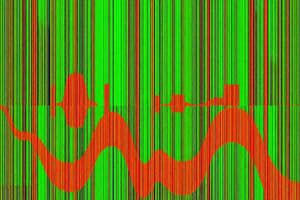Podcast
Questions and Answers
In an M-ary signaling scheme, what is the relationship between the number of bits (k) per symbol and the number of possible symbols (M)?
In an M-ary signaling scheme, what is the relationship between the number of bits (k) per symbol and the number of possible symbols (M)?
- $k = 2M$
- $M = k^2$
- $k = M^2$
- $M = 2^k$ (correct)
An optimal receiver is designed to:
An optimal receiver is designed to:
- Minimize the noise power.
- Maximize the bandwidth efficiency.
- Minimize the probability of error. (correct)
- Maximize the signal power.
What are the two main sub-blocks of an optimum receiver?
What are the two main sub-blocks of an optimum receiver?
- Modulator and Demodulator
- Amplifier and Filter
- Encoder and Decoder
- Signal Demodulator and Detector (correct)
What is the role of the Signal Demodulator in an optimal receiver?
What is the role of the Signal Demodulator in an optimal receiver?
In the context of a signal demodulator, what does 'N' represent?
In the context of a signal demodulator, what does 'N' represent?
What is the primary function of the detector in an optimum receiver?
What is the primary function of the detector in an optimum receiver?
Which of the following is a type of signal demodulator?
Which of the following is a type of signal demodulator?
What operation is performed by a correlation-type demodulator on the received signal?
What operation is performed by a correlation-type demodulator on the received signal?
What is the purpose of passing the received signal through a parallel bank of N correlators in N-dimensional signal demodulation?
What is the purpose of passing the received signal through a parallel bank of N correlators in N-dimensional signal demodulation?
In a correlation-type demodulator, what is the function of the integrator?
In a correlation-type demodulator, what is the function of the integrator?
What is the relationship between the outputs of a matched filter type demodulator and a correlation type demodulator?
What is the relationship between the outputs of a matched filter type demodulator and a correlation type demodulator?
In a matched filter type demodulator, what is the impulse response of the filter in the k-th branch?
In a matched filter type demodulator, what is the impulse response of the filter in the k-th branch?
If a signal s(t) is confined to the time interval $0 \le t \le T$, what is the impulse response h(t) of its matched filter?
If a signal s(t) is confined to the time interval $0 \le t \le T$, what is the impulse response h(t) of its matched filter?
What does the output vector r of the demodulator represent in the context of an optimum detector?
What does the output vector r of the demodulator represent in the context of an optimum detector?
In an N-dimensional signal space, what statistical property is assumed for the noise vector n?
In an N-dimensional signal space, what statistical property is assumed for the noise vector n?
What is the significance of the spherical symmetry of the noise vector in N-dimensional space?
What is the significance of the spherical symmetry of the noise vector in N-dimensional space?
When a symbol $s_m$ is transmitted, what does the received signal vector r represent?
When a symbol $s_m$ is transmitted, what does the received signal vector r represent?
What is the task of the optimum detector?
What is the task of the optimum detector?
Which criterion is used to form the decision in an optimal receiver?
Which criterion is used to form the decision in an optimal receiver?
What is the Maximum a Posteriori (MAP) criterion?
What is the Maximum a Posteriori (MAP) criterion?
Under what condition does the decision criterion simplify to selecting the signal with the minimum Euclidean distance from the observation point?
Under what condition does the decision criterion simplify to selecting the signal with the minimum Euclidean distance from the observation point?
What is the Maximum Likelihood (ML) criterion?
What is the Maximum Likelihood (ML) criterion?
What does the bit error rate (BER) represent?
What does the bit error rate (BER) represent?
For a binary antipodal signal, what is a key characteristic?
For a binary antipodal signal, what is a key characteristic?
What is the relationship between the probability of error and the signal-to-noise ratio (SNR)?
What is the relationship between the probability of error and the signal-to-noise ratio (SNR)?
Flashcards
Optimum Receiver
Optimum Receiver
A receiver designed to minimize the probability of error in detecting transmitted signals.
Signal Demodulator
Signal Demodulator
Converts the received signal into a vector, often using correlation or matched filter techniques.
Detector
Detector
Decides which of the possible transmitted signals is most likely based on the demodulated signal.
Correlation Type Demodulator
Correlation Type Demodulator
Signup and view all the flashcards
Matched Filter Type Demodulator
Matched Filter Type Demodulator
Signup and view all the flashcards
Receiver Vector Output
Receiver Vector Output
Signup and view all the flashcards
Maximum A Posteriori (MAP) Criterion
Maximum A Posteriori (MAP) Criterion
Signup and view all the flashcards
Maximum Likelihood (ML) Criterion
Maximum Likelihood (ML) Criterion
Signup and view all the flashcards
Probability of Error
Probability of Error
Signup and view all the flashcards
Bit Error Rate (BER)
Bit Error Rate (BER)
Signup and view all the flashcards
Binary Antipodal Signal
Binary Antipodal Signal
Signup and view all the flashcards
Binary Orthogonal Signal
Binary Orthogonal Signal
Signup and view all the flashcards
Signal-to-Noise Ratio (SNR)
Signal-to-Noise Ratio (SNR)
Signup and view all the flashcards
Q-Function
Q-Function
Signup and view all the flashcards
Distance Between Signal Points
Distance Between Signal Points
Signup and view all the flashcards
Study Notes
- A digital communication system transmits digital information using an M-ary signaling scheme.
- The bit stream gets divided into k-bit symbols, resulting in 2^k = M possible symbols.
- These symbols are converted to corresponding signals from the set {sm(t), m = 1, 2, ..., M} and transmitted at each signaling interval T.
- The received signal in an interval is given by r(t) = sm(t) + n(t), where 0 ≤ t ≤ T.
- n(t) represents the sample function of an Additive White Gaussian Noise (AWGN) process with a power spectral density of Sn(f) = N₀/2 watt/Hz.
- The optimum receiver's purpose is to minimize the probability of error
Optimum Receiver Sub-blocks
- Signal Demodulator
- Detector
Signal Demodulator
- Converts the received signal r(t) into an N-dimensional vector r = (r₁, r₂, r₃, r₄, ..., rN) in each signaling interval, with N being the dimension of the transmit signal space.
- ri, where i = 1, 2, ..., N, is the coefficient corresponding to the i-th basis function.
- r = r₁ψ₁(t) + r₂ψ₂(t) + r₃ψ₃(t) + ... + rNψN(t)
Detector
- Decides which of the M possible signal waveforms was transmitted based on observing the received signal vector r in each signaling interval.
Types of Signal Demodulators
- Correlation type demodulator
- Matched filter type demodulator
Correlation-Type Demodulator
- Multiplies the received signal with the carrier (orthonormal basis function), then integrates (using an LPF), and samples the result at every signaling interval.
- For N-dimensional signal demodulation, the signal passes through a parallel bank of N correlators.
- The k-th branch of the correlator multiplies with the k-th basis function ψk(t) integrating the output.
- Integrator output gets sampled, resulting in rk at every sampling interval.
- Mathematically, ∫₀^T r(t)ψk(t)dt = ∫₀^T [sm(t) + n(t)]ψk(t)dt, where k = 1, 2, ..., N and rk = smk + nk.
- Here, smk = ∫₀^T smk(t)ψk(t)dt and nk = ∫₀^T n(t)ψk(t)dt, representing the noise component along the k-th function.
- The signal can be synthesized as r(t) = Σ(k=1 to N) smkψk(t) + Σ(k=1 to N) nkψk(t) = Σ(k=1 to N) rkψk(t).
Matched Filter Type Demodulator
- Passes the received signal r(t) through a parallel bank of N linear filters.
- The impulse response of the filter in the k-th branch is given by hk(t) = ψk(T - t), where 0 ≤ t ≤ T, and k = 1, 2, ..., N.
- N represents the dimension of the signal space, and ψk(t) is the k-th basis function.
- The k-th filter output is: yk(t) = r(t) * hk(t) = ∫₀^t r(τ)hk(t - τ) dτ = ∫₀^t r(τ)ψk(T - t + τ) dτ.
- Sampled at t = T, yk(t) = ∫₀^t r(τ)ψk(τ) dτ.
- For a signal s(t) confined to a time interval of 0≤t≤T, the matched filter has an impulse response of h(t) = s(T - t).
Optimum Detector
- Receives a vector r = (r₁, r₂, r₃, r₄, ..., rN) from the demodulator output, which is the sum of the transmitted signal sm and the noise vector n.
- The sm vector represents a signal at a point on an N-dimensional signal space.
- The n vector is an N-dimensional random vector following an independent Gaussian (Normal) distribution, with a zero mean and a variance of N₀/2.
- The noise vector n possessing spherical symmetry in N-dimensional space.
- When symbol sm gets transmitted, the received signal vector r gets represented by a spherical cloud centered at sm.
- The value N₀/2 defines the density of the noise cloud.
- Task makes a decision on the signal sm from observation r in each interval with the least probability of error.
Decision Criterion
- Criterion formed is centered on the posterior probability, defined by the probability of transmitting sm, given that r is observed.
- Criterion picks the signal having maximum posterior probability from the potential probabilities {P(sm/r), m = 1, 2, ..., M}.
- The estimate of the transmitted signal is: ŝ = arg max P(sm/r).
- This approach is called the maximum a posterior (MAP) criterion.
- In the special instance where all M symbols are equiprobable (i.e., P(sm) = 1/M, m = 1, 2, ..., m), the condition picks the signal having minimum Euclidean distance from the observation point.
- ŝ = arg max Σ(k=1 to N) ||rk - smk||².
- The decision criterion is called the maximum likelihood (ML) criterion.
Probability of Error
- Probability represents the likelihood of the detector making a wrong decision.
- For a binary signal, the detector identifies s₁ when s₂ is transmitted, or vice versa.
- Bit error rate (BER) refers to the probability of errors based on the number of bit errors that occurred relative to the total bits sent.
Binary Antipodal Signal
- Binary antipodal signals are represented with a single-dimensional vector space
- s₁ = √Eb and s₂ = -√Eb, with both signals being equally likely.
- The received signal is r = {s₁ + n = √Eb + n} or {s₂ + n = -√Eb + n}.
- n is an additive noise component that follows a Gaussian distribution with zero mean and variance N₀/2.
- The conditional PDF of the received signal r when s₁ is transmitted is: f(r/s₁) = (1/√(πN₀)) * exp(-(r - √Eb)² / N₀). Conversely, for s₂, f(r/s₂) = (1/√(πN₀)) * exp(-(r + √Eb)² / N₀).
- For equiprobable signals, the formula to calculate the threshold is TH = (√Eb - √Eb) / 2 = 0.
- The detector opts to choose s₁ when r > 0; otherwise, it selects s₂. The likelihood of error if s₁ is the signal sent: P(e/s₁) = ∫(-∞ to 0) f(r/s₁)dr. Where P(e/s₁) = ∫(-∞ to 0) (1/√(πN₀)) * exp(-(r - √Eb)² / N₀) dr.
- The probability of error hinges on the ratio between bit energy (Eb) and noise PSD (N₀), defining the signal-to-noise ratio (SNR).
- Given that the Q-function has an inverse relation with SNR, boosting SNR levels reduces error probability.
- The Euclidean distance between two signals on a vector space: d = 2√Eb.
- Error calculation formula: Pe = Q(√(d² / 2N₀)).
Binary Orthogonal Signal
- Binary orthogonal signal: Two signal points are represented with two orthonormal basis functions.
- The Euclidean distance between two signal points on vector space: d = √2Eb.
- Pe = Q(√(Eb / N₀)).
- Q(0) = 0.5, i.e., the maximum bit-error-rate is 0.5.
Studying That Suits You
Use AI to generate personalized quizzes and flashcards to suit your learning preferences.




